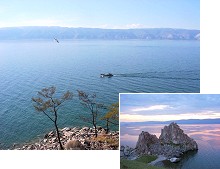| Origin & Development | |
|
Legends & Fairy tales • Earth's Crust Thickness • Underwater Relief • Landscapes • History & Formation • Seismic Activity • | |
| History of Lake Baikal | |
|
History of Explorations • Inhabitants & Settlers • First maps of Baikal • Archaeological Sites • | |
| Lake Baikal Climate | |
|
Introduction • Fogs • Winds & Waves • Ice Conditions • | |
| Fauna & Vegetation | |
|
Mammals • Baikal seal - Nerpa • Ichthyofauna • Invertebrates • Vegetation • | |
| Water of Lake Baikal | |
|
Colour • Transparency • Temperature • Pressure • Depth • Currents • Budget • Chemical Composition • Pollution • | |
| Recreational Areas | |
|
Circumbaikal Railway • Peschanaya Bays • Olkhon Island • Chivirkuysky Gulf • Wooden Irkutsk • Trans-Siberian Railway • | |
| People of Lake Baikal | |
|
People of Siberia • Buryat nation in Baikal • Russians in Baikal • | |
|
| |
Small Sea / Olkhon Island
Maloye Morye is separated from the open Baikal by Olkhon Island stretching for 72 km along the continental shore. "Olkhon" means "windy, sunny" in the Buryat language (the original language of the region). By a process still not understood winds drive away heavy clouds past Olkhon, and thus, there are more sunny day here than on the Black Sea coast. The shape of island resembles Baikal, and like the lake itself, it also unique, beautiful and mysterious. In summer the southern section of the island is saturated with fragrance of steppe grasses. The north is woody, with ridges about 900 m high which, in the east are abruptly replaced by cliffs sliding directly into the water. The western coast is not high, it is whimsically jagged with tiny bays and capes. Olkhon Island distinguished not only by its scenery but by its different climate: it seldom rains and it is not often foggy here and the weather is rather predictable. Olkhon is the only; island on Lake Baikal where there has been human habitation since pre-historic times. |
